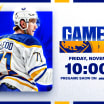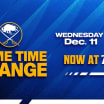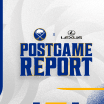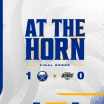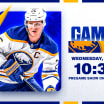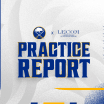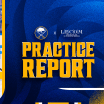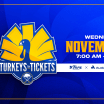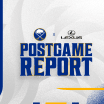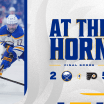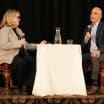It was June of 2007 when Jon Miller sat down for a lunch with his old friend John Collins and had a conversation that would set the course for the Winter Classic as we know it. Miller had conceived the idea for an outdoor hockey game three years earlier, and had since pushed the idea on to everyone from NHL commissioner Gary Bettman to New York Yankees president Randy Levine.
It wasn't until Collins, with whom Miller had worked for decades through NBC's association with the NFL, signed on with the NHL in 2006 that the idea had really begun to gain traction. Collins embraced the idea, and it had already been on his agenda to build an in-house special events team that would be capable of executing such an event.
When the two arrived for lunch on that summer day in 2007, Collins said he had both good news and bad news for Miller. The good news was that there had been interest in the outdoor game. The bad news was, after surveying the clubs that were capable of hosting the event, only one expressed willingness.
The Buffalo Sabres.
10 Years Later: A look back at the 1st NHL Winter Classic
Sabres.com talked to the key players on and off the ice who created a hockey tradition
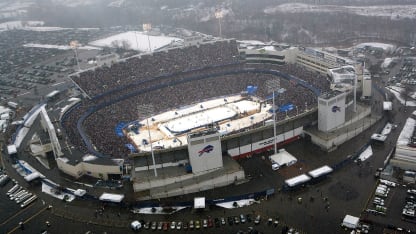
© Claus Andersen/Getty Images
"I said, 'Sold,'" Miller recalls. "He said, 'Really?' I said, 'Absolutely.'"
The origins of the first Winter Classic can be traced in a variety of directions; depending on who you ask, the event may have never been conceived if not for a remarkable comeback by the Boston Red Sox in the 2004 ALCS, and it may have never been accepted had it not been for the shrewdness of Dallas Cowboys owner Jerry Jones.
But in order for the Winter Classic to become an event that now, 10 years later, remains the NHL's marquee regular season game and a New Year's Day tradition for hockey fans, it took a perfect set of circumstances - circumstances that may have only been possible in Buffalo, N.Y.
The idea
In the spring of 2004, when NBC had acquired the broadcasting rights for the NHL, Miller was already in the process of trying to fill programming on New Year's Day. Over the years, the network had virtually gotten out of the business of airing college football bowl games - the lone bowl they had left was the Gator Bowl in Jacksonville, Florida.
At the same time, Miller said, college football had all but ceded the day. Most of the major bowls had been moved to primetime slots throughout the week, leaving just the Rose Bowl and either the Sugar Bowl or the Orange Bowl to be played on New Year's Day, both of which were played in the evening.
"The rest of the bowls were what I used to call the 'Who Takes out the Trash Bowl,'" Miller said. "They were bowls that people just really didn't put a lot of attention in. They were good games and they were fun games for those teams and those schools to go play in, but they didn't really impact the college football national championship picture and you were not getting the cream of the crop of each conference. So we saw that as an opportunity."
Initially, the NHL hadn't been on Miller's mind in regards to that New Year's timeslot.
That changed in fall of 2004, when the Boston Red Sox erased a 3-0 deficit against the New York Yankees in the American League Championship series and went on to win their first World Series Championship in 86 years. With the Yankees and Red Sox at the height of their rivalry, an idea had been sparked.
"In thinking about it, and thinking I had to come up with a way to fill New Year's Day programming, the idea kind of hit me," Miller recalls. "Why don't we have the Rangers play the Bruins at Yankee Stadium, and that will be the way NBC kicks off the new relationship with our first game as part of our 2005-06 contract?"
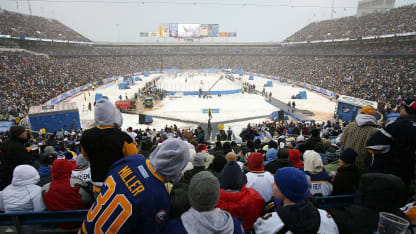
© Bill Wippert/Getty Images
Miller brought the idea to his boss, Dick Ebersol, who he said was receptive but skeptical about how the league would react. From there he brought it to Bettman, who was also receptive, but hesitant because the league at that time did not have its own special events department.
The Bruins liked the idea, but the Rangers' lease with Madison Square Garden required them to play all 41 of their home games at the venue. Meanwhile, Levine and Lonn Trost of the Yankees, Miller said, were skeptical about having a hockey game played at the "The House That Ruth Built."
Miller believed in the idea though, and he was still in need of both New Year's Day programming and a way to launch the network's relationship with the NHL. Thus he persisted as time went on, and Bettman remained open-minded to the idea.
"Gary Bettman to this day kind of teases me that I was always in his ear," he said. "Whenever we would meet to discuss other things as we got ready for the start of next season, he'd say 'I know you really want to do this outdoor game, you're never going to let it go.' That kind of stuff.
"I said, 'I really think it's a good idea and one that we need to try to find a way to make happen.'
Internal support
Collins came into the NHL in November of 2006 with an NFL background, and the mindset to take what he had learned in football and apply it to hockey. Specifically, in their first meeting, he and Bettman spent multiple hours discussing what the NFL had done in launching its event calendar and how the NHL could follow suit.
The roots of the NFL's marketing calendar, Collins said, had begun with commissioner Roger Goodell and the league's business ventures committee, which at the time included Jerry Jones, former Jacksonville Jaguars owner Wayne Weaver and New England Patriots owners Robert and Myra Kraft.
The committee was working toward a direction for the league upon the expiration for the NFL Trust, an agreement that had been negotiated by former commissioner Pete Rozelle that placed all team marks and logos in a central pool and granted licensing rights to the league, with revenues to be shared.
Jones and other owners believed there was a better way, that teams should have the right to license their logos individually.
"Jerry at that point was the maverick," Collins said. "But he was also joined by a lot of other owners who felt like their might be another way to do it. A lot of that work revolved around, 'How do we keep the real strength of the NFL in terms of shared revenues, and therefore a lot of the competitive balance, how do we keep that in place while still changing the model?"
The answer, Collins said, was returning the logo rights to their respective clubs and shifting the league's focus more toward building out its marketing calendar.
"It was, 'How do we introduce kickoff?' 'How do we make Thanksgiving bigger?' 'How do we make the playoffs new and different?'" he said. "The Super Bowl had been the Super Bowl, but how do we make that even bigger? And the individual marks of the 31 clubs would go back to the clubs in the new agreement."
Collins estimates that in the 14 months after the new agreement was ratified, the NFL racked up roughly $1.5 billion in sponsorship deals.
"It not only gave validation to the new business model, but it also created a new path for the NFL to market in terms of the event calendar," he said. "Everyone talks about the NFL being a 365-day-a-year business, but that was truly the beginning of the 365-day business."
Thus, when Collins came on board with the NHL, he and Bettman had their sights set on applying that same theory to create more national revenue for the league. The rallying cry, Collins said, was to build national scale at the league level.
Another lesson Collins learned during his time in the NFL was the importance of the broadcast model. When a broadcast partner has as much skin in the game for an event as the league, they take it upon themselves to drive promotion to ensure that the event is a success.
It just so happens that, on the day that Collins first met with Bettman, Miller was also in the building to introduce Seth Winter, NBC's new head of sales. As Collins wrapped up his meeting with Bettman, the commissioner invited him into the room where Miller was waiting.
"Jon was sort of like, 'What are you doing here? You're an NFL guy," Collins said.
"John and I had worked together for close to 20 years before that through different iterations when he was at the NFL, so it was great to see him," Miller said. "We went off into a corner and he said, 'So, tell me what I can do to help you with your NHL relationship?'"
Creating a Classic
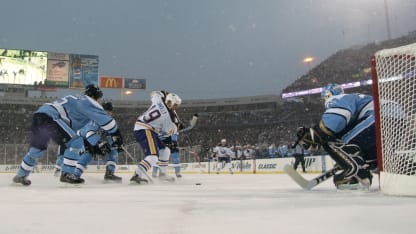
© Bill Wippert/Getty Images
It was summer of 2007 when then Buffalo Sabres president Larry Quinn received a phone call from Bettman as he was walking into work. The commissioner informed him of the idea to put on an outdoor game on New Year's Day, and asked if the Sabres would be interesting in hosting. Quinn said yes.
"He says, 'Great, because nobody else is willing to take the risk,'" Quinn said.
Back then, Quinn said, the Sabres had developed a reputation for being willing to experiment with ideas that could serve the greater good of the league. They had experimented with different-sized nets, and even blue ice for a Rochester Americans game hosted at what is now KeyBank Center during the 2004-05 season. In that sense, they were a logical partner.
There was also the fact that both Bettman and Miller believed in Buffalo as a market. Miller had become familiar the fan base through the NFL, having held broadcast rights during the Buffalo Bills' run to four straight Super Bowls in the early 1990s.
"I think Buffalo may be one of the great sports markets in America," Miller said. "We looked at ratings of local teams and the way they follow hockey; Buffalo was consistently in the top three of every city in country in terms of following their hockey team. So we know that they're a rabid hockey town. For us, we didn't have any doubt that they would support it."
Quinn pitched some of ideas of his own for the game, suggesting they leverage the high demand for Buffalo's game against Toronto and make it an international game played with Niagara Falls as the backdrop. The league's preference had been Orchard Park, however, and thus an agreement would have to be reached with the Bills and their owner, Ralph Wilson.
"I remember pretty early on, yeah, there was some hesitancy," Quinn said. "So I called Ralph, and he was great. He couldn't have been a better partner for us."
"I think a guy who was incredibly critical to getting it off the ground was [team president] Russ Brandon," Collins said. "I called Russ and pitched him the idea, and it wasn't a no-brainer, for sure. He had to think about what the potential impact could be to the Bills' NFL schedule."
When Collins met Miller to inform him that Buffalo was willing to host the game, Miller immediately saw Pittsburgh as a potential opponent. The Penguins boasted the league's marquee star in forward Sidney Crosby, who at age 19 had just led the entire NHL with 120 points.
"John said, 'Really? You'd put Pittsburgh and Buffalo on New Year's Day?'" Miller recalls. "I said - in a heartbeat - 'Let's do it.'
"He said, 'Let me get back to you.'
"A couple weeks later he called and said, 'OK, both teams said they can do it and Buffalo said they can get the stadium.'"
Eventually, the league settled on a name for their event: the Winter Classic. Initially, Miller said, they had wanted to call it the Ice Bowl, a callback to the 1967 NFL Championship Game between the Dallas Cowboys and Green Bay Packers, but the toy company Wham-O! had already copyrighted that phrase for one of its products.
They tossed around more names - the Winter Challenge, The Challenge - before finally landing on Winter Classic.
For as much confidence as there was in the Buffalo market, there was still the question of whether or not the NHL could sell out a stadium that seated more than 70,000 people. The moment of truth came in September 2007, when tickets went on sale to the general public.
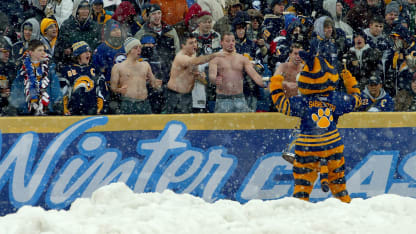
© Dave Sandford/Getty Images
"I remember we were having a board meeting, a governor's meeting, the day that we went on public sale," Collins said. "I think the meeting was starting at 10 a.m. and I think we had gone on sale at 9 a.m. Just as he was ready to start the meeting, I kind of whispered into Gary's ear, 'We're sold out.'"
"It sold out in 18 minutes," Bettman recalled during a phone interview. "It put a smile on my face then and, you can't see me, but talking about it now puts a smile on my face. It just tells you that hockey fans are the greatest."
The game
If there's one shared memory of Ralph Wilson Stadium on Jan. 1, 2008 that really stands out - aside from the way the game ended - it's the scene that had already been created in the parking lots by the time the teams had arrived.
It was exactly as Collins had envisioned; a hockey game being treated like a football game. Miller compared the atmosphere to the 1991 AFC Championship Game, when the Bills beat the Los Angeles Raiders.
"You know how you go to a Bills game and there's people throwing footballs around? There were people that had set up hockey nets and they were playing street hockey games in the Bills parking lot," Quinn said. "I just thought to myself, this never would have been done in another city. People wouldn't have done that. It was great. Buffalo has a lot to be proud of in this thing."
"At that point it kind of hits you - this is going to be a fun day," Sabres forward Jason Pominville said. "And it was."'

© Bill Wippert/Getty Images
The weather cooperated, too, with the lake effect snowfall creating a snow globe-like atmosphere within the stadium. While it may not have made for ideal hockey conditions - there had to be several stoppages to remove snow buildup from the ice - it was a perfect setting for the game to be played, both for the fans in the stadium and those watching on TV.
"When I walked onto the field and it was snowing, and I looked at all the people, it was breathtaking," Bettman said. "It made the hair on the back of my neck stand up because it was clear to me that this was something very special. Whatever we had seen before, this was going to be a really big deal."
"I remember Jon Miller, standing on the field before the anthem, he turned to me and said, 'This is what it felt like when we'd be coming up here for the great Bills AFC Championship games,'" Collins said. "It felt exactly the same."
Some of the Sabres contributed to the old-time feel of the event with their choices of apparel. Lindy Ruff, who was then head coach of the team and now works as an assistant coach with the New York Rangers, wore a varsity jacket on the bench, one he still owns to this day.
Goalie Ryan Miller, meanwhile, had two years prior started his Steadfast Foundation to assist young people battling cancer. He saw the national stage as an opportunity to raise money toward that end, and partnered with a company that fashions hockey socks to double as toques and wore one over his mask.
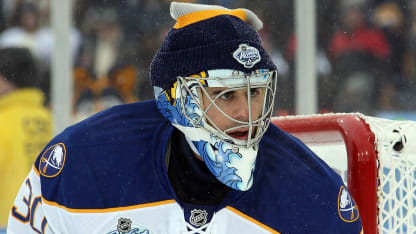
© Bill Wippert/Getty Images
"It wasn't something where I went way out of my way to throw a sock on my head," Miller said. "But I thought we had a chance to use the platform. It actually almost didn't work out - the NHL wasn't thrilled about it … They took it as I was branding something. I said, 'No, it's not for me. It's awareness, a charity thing, it's a good opportunity to do something.' They signed off at the last second."
The game itself was unpredictable. Colby Armstrong scored on the very first shift of the game for Pittsburgh, just 21 seconds into the contest, opening the door for a high-scoring affair. As the snow picked up, however, the scoring opportunities lessened.
"We really didn't know what to expect after that," Ruff said. "We didn't expect it to snow as hard as it did at times. When it started snowing that hard, you knew there wasn't going to be a lot of great opportunities. At the end, for us to even it up, I think the score we were able to get it to, was probably what you had to expect, given the weather conditions."
"The predictability of the game was kind of gone," Miller said. "Do I go play the puck behind the net, or was it going to stop in the corner? Or do I race out to play an icing because it's not going to make it? You just had to prepare yourself for the puck not to do what you expect it to do."
There were other factors to account for. Miller said the wind picked up at the tunnel end, and in those moments, he began to empathize with NFL kickers. Then there were the frigid temperatures, which most affected those on the bench.
"The players that were sitting there that weren't getting a lot of shifts, they were the ones whose feet were getting cold," assistant equipment manager George Babcock said. "When you take a puck to the foot when your feet are cold, that's not too much fun."
Eventually, breaks taken to tend to the ice conditions served as opportunities for players to soak in the moment.
"There were so many plays with the snow and the ice, the game took a while," Pominville said. "There were a lot of moments when you were just sitting there and looking around, and just kind of being in awe at what's going on."
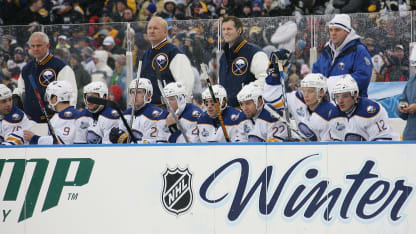
© Bill Wippert/Getty Images
The Sabres tied the game on a goal from defenseman Brian Campbell in the second period. That's where the score would stand until the end of regulation, and then the end of overtime. The inaugural Winter Classic would end in a shootout.
Alex Kotalik scored on Buffalo's first attempt, but Pittsburgh evened the score later with a goal from defenseman Kris Letang.
"I couldn't see the puck," Letang said. "I was just trying to push it through the snow. When I was able to see it a little bit, I was able to make a move and score. But it was tough, because we couldn't see anything. I even took off my visor during the game because I couldn't see."
Following an unsuccessful attempt from Buffalo forward Maxim Afinogenov, the game rested on the shoulders of Crosby. It was a storybook ending for the NHL; as Pominville described it, the man who would soon become arguably the world's best goalie facing the world's best young player.
Crosby slowly carried the puck toward Miller, then beat him with a shot at the last second to earn a 2-1 victory for Pittsburgh. Miller still remembers how the play developed 10 years later.
"I would have liked to play it better but, again, he takes what you give him," Miller said. "I thought he was kind of dragging the puck a little bit through the snow. I was trying to give him a little bit of a chip check and I think he saw it coming a little bit at the last second there and just tried to change the angle. That's twice in my career where I made a decision that went wrong on Sid in an important moment. But you make your decision, you make your choice and you kind of live with it."
For the league, Crosby's goal was the perfect end to a perfect day. Jon Miller was vindicated: The Winter Classic was NBC's highest-rated game of season.
Fans who tuned in to that snowy afternoon in Orchard Park came back the following year, and the event has gone on to stand as the network's highest-rated regular-season game in each of its nine years.
"All of the elements coming together: being in Buffalo, seeing the lake effect snow, the fact that the stadium was full, the decibel level of the sounds of the crowd, even as you came to the stadium and you saw the tailgating - everything came together," Bettman said. "And then the game went into overtime, and then there was a shootout. I mean, wow.
"If you were scripting it, and I assure you we didn't, you couldn't have scripted it any better for the first Winter Classic."
It's become a marquee event in the NHL and a New Year's tradition for hockey fans. It wouldn't have been possible had it not been for the willingness of the Sabres to take a risk, the magic of Buffalo on a winter day and - perhaps most importantly - the embrace from the people of Western New York.
"Buffalo," Quinn said, "is the only city that could have pulled it off."





